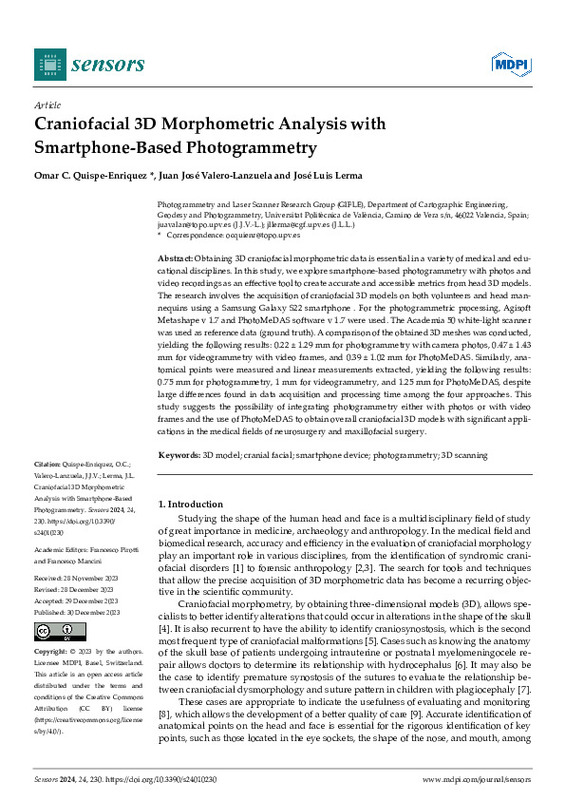JavaScript is disabled for your browser. Some features of this site may not work without it.
Buscar en RiuNet
Listar
Mi cuenta
Estadísticas
Ayuda RiuNet
Admin. UPV
Craniofacial 3D Morphometric Analysis with Smartphone-Based Photogrammetry
Mostrar el registro sencillo del ítem
Ficheros en el ítem
| dc.contributor.author | Quispe-Enriquez, Omar C.
|
es_ES |
| dc.contributor.author | Valero-Lanzuela, Juan José
|
es_ES |
| dc.contributor.author | Lerma, José Luis
|
es_ES |
| dc.date.accessioned | 2024-01-30T19:01:17Z | |
| dc.date.available | 2024-01-30T19:01:17Z | |
| dc.date.issued | 2024-01 | es_ES |
| dc.identifier.uri | http://hdl.handle.net/10251/202228 | |
| dc.description.abstract | [EN] Obtaining 3D craniofacial morphometric data is essential in a variety of medical and educational disciplines. In this study, we explore smartphone-based photogrammetry with photos and video recordings as an effective tool to create accurate and accessible metrics from head 3D models. The research involves the acquisition of craniofacial 3D models on both volunteers and head mannequins using a Samsung Galaxy S22 smartphone . For the photogrammetric processing, Agisoft Metashape v 1.7 and PhotoMeDAS software v 1.7 were used. The Academia 50 white-light scanner was used as reference data (ground truth). A comparison of the obtained 3D meshes was conducted, yielding the following results: 0.22 ± 1.29 mm for photogrammetry with camera photos, 0.47 ± 1.43 mm for videogrammetry with video frames, and 0.39 ± 1.02 mm for PhotoMeDAS. Similarly, anatomical points were measured and linear measurements extracted, yielding the following results: 0.75 mm for photogrammetry, 1 mm for videogrammetry, and 1.25 mm for PhotoMeDAS, despite large differences found in data acquisition and processing time among the four approaches. This study suggests the possibility of integrating photogrammetry either with photos or with video frames and the use of PhotoMeDAS to obtain overall craniofacial 3D models with significant applications in the medical fields of neurosurgery and maxillofacial surgery. | es_ES |
| dc.description.sponsorship | Instituto de Salud Carlos III under project number PI22/01416 and joint financing by the European Union | es_ES |
| dc.language | Inglés | es_ES |
| dc.publisher | MDPI AG | es_ES |
| dc.relation.ispartof | Sensors | es_ES |
| dc.rights | Reconocimiento (by) | es_ES |
| dc.subject | 3D model | es_ES |
| dc.subject | Cranial facial | es_ES |
| dc.subject | Smartphone device | es_ES |
| dc.subject | Photogrammetry | es_ES |
| dc.subject | 3D scanning | es_ES |
| dc.subject.classification | INGENIERIA CARTOGRAFICA, GEODESIA Y FOTOGRAMETRIA | es_ES |
| dc.title | Craniofacial 3D Morphometric Analysis with Smartphone-Based Photogrammetry | es_ES |
| dc.type | Artículo | es_ES |
| dc.identifier.doi | 10.3390/s24010230 | es_ES |
| dc.relation.projectID | info:eu-repo/grantAgreement/ISCIII/Plan Estatal de Investigación Científica, Técnica y de Innovación 2021-2023/PI22%2F01416/ES/Optimización de tecnología con teléfono móvil e inteligencia artificial para diagnóstico y seguimiento de deformaciones craneofaciales en lactantes/ | es_ES |
| dc.rights.accessRights | Abierto | es_ES |
| dc.contributor.affiliation | Universitat Politècnica de València. Escuela Técnica Superior de Ingeniería Geodésica, Cartográfica y Topográfica - Escola Tècnica Superior d'Enginyeria Geodèsica, Cartogràfica i Topogràfica | es_ES |
| dc.contributor.affiliation | Universitat Politècnica de València. Departamento de Ingeniería Cartográfica Geodesia y Fotogrametría - Departament d'Enginyeria Cartogràfica, Geodèsia i Fotogrametria | es_ES |
| dc.description.bibliographicCitation | Quispe-Enriquez, OC.; Valero-Lanzuela, JJ.; Lerma, JL. (2024). Craniofacial 3D Morphometric Analysis with Smartphone-Based Photogrammetry. Sensors. 24(1). https://doi.org/10.3390/s24010230 | es_ES |
| dc.description.accrualMethod | S | es_ES |
| dc.relation.publisherversion | https://doi.org/10.3390/s24010230 | es_ES |
| dc.type.version | info:eu-repo/semantics/publishedVersion | es_ES |
| dc.description.volume | 24 | es_ES |
| dc.description.issue | 1 | es_ES |
| dc.identifier.eissn | 1424-8220 | es_ES |
| dc.identifier.pmid | 38203091 | es_ES |
| dc.identifier.pmcid | PMC10781299 | es_ES |
| dc.relation.pasarela | S\506349 | es_ES |
| dc.contributor.funder | INSTITUTO DE SALUD CARLOS III | es_ES |
| dc.subject.ods | 04.- Garantizar una educación de calidad inclusiva y equitativa, y promover las oportunidades de aprendizaje permanente para todos | es_ES |
| dc.subject.ods | 10.- Reducir las desigualdades entre países y dentro de ellos | es_ES |








